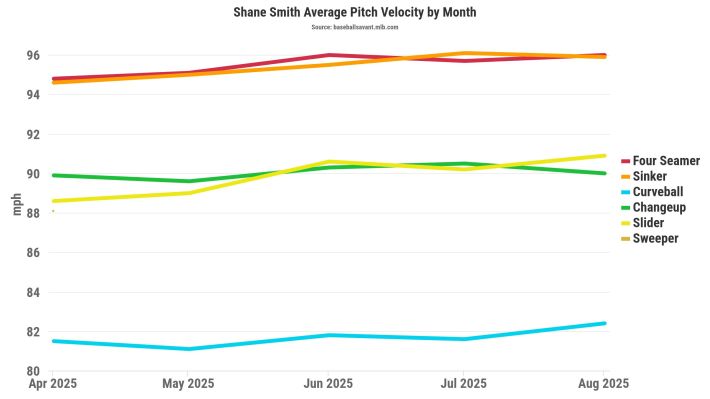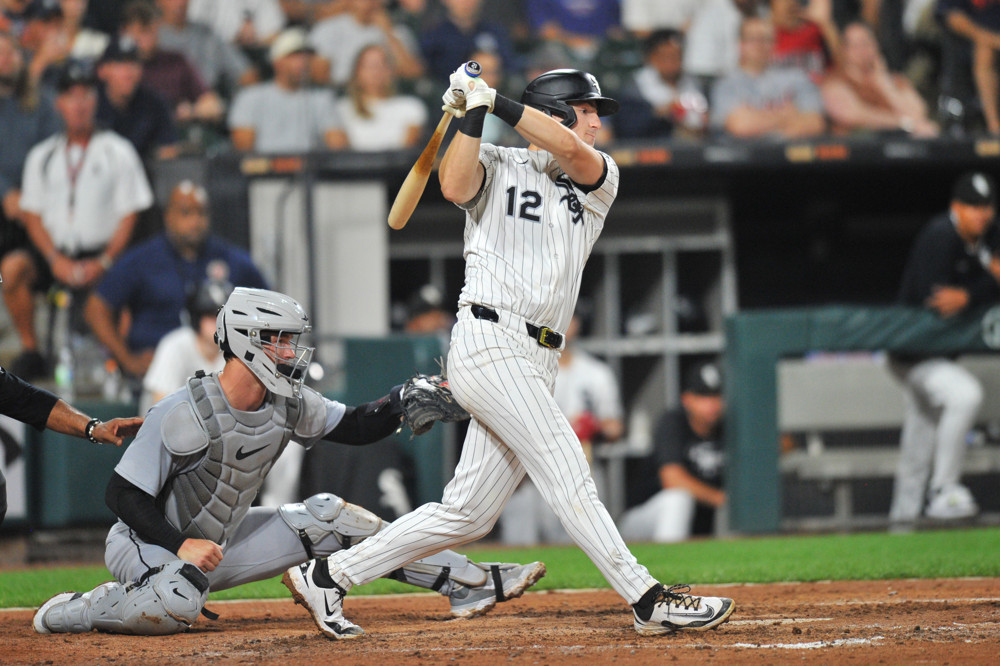Keeping his slider from getting too hard and cutter-like in shape has been a season-long project for Shane Smith. So his tone about it can sometimes take the tone of a disappointed father, where a question about what secondaries his new sinker tunnels with is a good opportunity to land a pointed barb.
"If my slider were any good, it would," Smith said
Optimistically, one of the breaking balls that helped Smith get picked first overall in the Rule 5 draft, is just going through a developmental phase his other misbehaving children, like the curveball he needs to stay on top of, or the seam-effects changeup he worked to stop yanking after the All-Star break.
But to hear Smith and the White Sox tell it, their favorite element of his recent work came as an adaptation to not having any of his offspeed pitches working during a yeoman's six innings and four runs allowed in Atlanta.
"He really couldn't get any of his secondary stuff going," pitching coach Ethan Katz recalled. "It was just fastball -- four-seam, sinker -- but that just got to show how good he was. One of the biggest things for me, and we talked through this, in Anaheim, I really did not like how he was going about his business. I really thought he was trying to nibble, overthinking things. So we had a conversation about that because I thought the best version of him was when he got after guys, attacking guys. And he really responded really well to that message."
"Throwing everything with conviction and you're not worried about the result after the ball leaves your hand," Smith said, showing his interpretation of the approach. "It's easy to get caught in the, 'If I miss here, if I miss there,' damage, whatever it is, you know, just keep throwing your stuff."
After wrapping up a resurgent month of August that saw him hold a 2.67 ERA in 33⅔ innings, the White Sox are signaling that they're comfortable with Smith making the rest of his starts through the end of the year. With his velocity up a tick from even the 94.8 mph he sat in April, the 25-year-old right-hander is looking physically up for powering to the finish. More velocity is helpful, because Smith's aggressive new approach is highly reliant on attacking with his sinker.


"It just gives me different looks, gets me in and out, gets me up and down," Smith said of the second fastball shape. A hitter can't cover every part of the plate. If they can, and some guys can, it's tough to do it pitch-to-pitch. You might do it over the course of an at-bat if I make a mistake, or go to the same quadrant more than once. But it's pretty hard to if I'm going two-seamer up and in, to a slider down and away, to four-seam up and away, to a changeup down and away. If you're taking and/or putting a barrel on everything you're really, really good at what you do."
If there's any lingering doubt for how much Smith is thinking through how having a new fastball shape gives him new quadrants of the strike zone to work, alongside the sort of randomized cut/ride action that his four-seamer offers, there are four more long quotes of him mapping out scenarios like the last one that could be dropped in here to dismiss such concerns. At this juncture of his first professional season that's been fully dedicated to starting, Smith feels like as much as his expanded arsenal has altered the course of his career, it's helped him get used to scraping together a game plan out of whatever options are working.
"I would throw in Double-A game last year usually having one pitch, and maybe a curveball that was like, decent," Smith said. "I would say my pitchability has gone up, just having more weapons. Even if the changeup is not perfect. I think I used 10 [the other day]. Got some takes, foul balls, popups. That's usable."
While giving Smith a new changeup scans as the main way they improved him from his prospect days with the Brewers, the White Sox Rule 5 leap of faith was inspired as much as anything in belief that his fastball would play, despite the lack of elite riding action. And that was before Smith established that he would be sitting 96 mph late into the year, or found a reliable cue for deploying a sinker grip.
With a more expanded arsenal in place, the White Sox aren't demanding perfection from Smith, but don't think he has cause to give in to timidity. There are only a handful of impact fastballs on staff, and Smith has one. The goal is to end the season pitching like it.
"For a young guy to have a tough game up here can really do some work to them upstairs, because then they start thinking about things, or if someone hits a pitch a certain way then they start going down some rabbit holes that maybe they don't need to," Katz said. "You're gonna have bad games. You're gonna go through some tough stretches. You're gonna have some days when you're just off mechanically. But trying to navigate and trying to keep the team in it is gonna be very important.
"For him, it's just staying locked in and trusting your stuff and trying to have those feedback loops to kind of show him this is how good your stuff is, this is what you're doing. Don't let this one little thing be a blip on the radar to where now you're starting to lose your confidence, or think that you don't have the same arsenal or something's not the same. Just stay the course and keep attacking guys."






